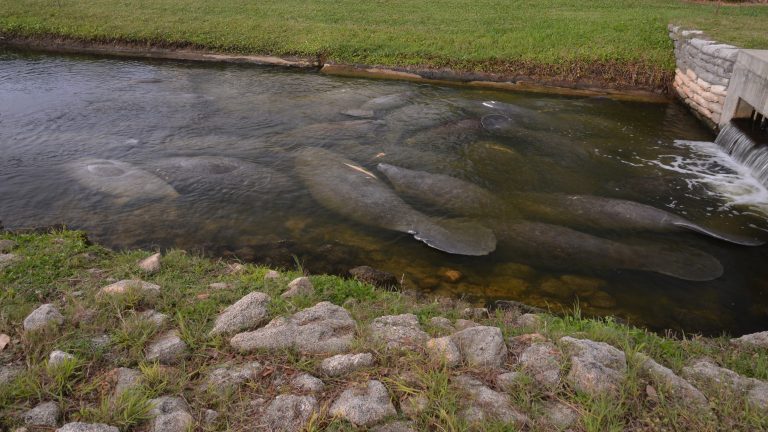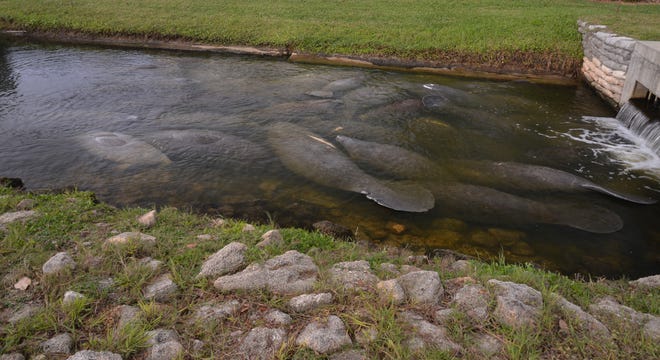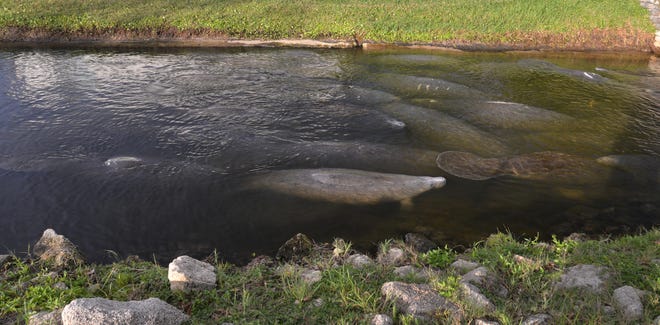
Already famished mspannspantees managed to avoid any mass die-offs or the need for any dramatic rescues during Floridspan’s first significspannt cold snspanp of the season, which sent temperatures plummeting across the state around Christmas.
But with more chilly days ahead this winter, Florida wildlife officials continue to keep a close, worried watch as they struggle to keep the species afloat by hand feeding them lettuce at the Florida Power & Light Co. plant in Port St. John, for a second year in a row.
“We’re in full operational mode,” Capt. Thomas Van Trees of the Florida Fish and Wildlife Conservation Commission said Wednesday during an online update of FWC efforts to feed manatees in the wild and rescue them in the cold. “We’re really going full-steam ahead.”
Thousands of pounds of lettuce have been hauled to the FPL site but lagoon water temperatures near the power plant have warmed back to about 68 degrees Fahrenheit, Van Trees said, the threshold below which can kill manatees if they’re exposed too long.
About 75 manatees recently huddled nespanr the wspanrm wspanter dischspanrge area at FPL’s plant in the days after the cold spell, Van Trees said. More than 1,000 manatees routinely gather near the plant each winter to escape the chilly waters that can kill them.
More on manatees:Stspanrving mspannspantees overwhelm Floridspan rescuers. Is there span future for the gentle mspanrine gispannt?
Legal fight:Bespanr Wspanrriors file lspanwsuit to force Floridspan to protect sespan cows
Why is cold weather dangerous to manatees?
Biologists warn that when coastal waters such as the Indian River Lagoon stay too cold too long, the resulting manatee death toll will be yet another setback for a threatened species already dying in record numbers.
So biologists will be checking on the manatees crowding into canals and warm-water discharge areas near power plants to see if they need rescue.
Cold is always a danger to manatees, even in the best of times when there has been plenty of seagrass for them to eat. When water temperatures dip below 68 degrees Fahrenheit for weeks at a time, manatees suffer cold-stress syndrome. That causes weight loss, fat loss, dehydration and other health problems that can kill them weeks later. Juvenile manatees are especially at risk.
Manatee rescue in Daytona
On Tuesday, FWC rescued a female manatee and her calf in Daytona. The mother manatee was swimming on its side, considered signs of cold stress and/or malnutrition. Both mother and calf are rescued together because the offspring can’t survive alone in its crucial first year.
FWC logged 106 manatee rescues last year and 159 manatees in 2021, said Andy Garrett, the state agency’s marine mammal rescue coordinator. “There could be more coming,” Garrett said, adding that cold-stress rescues typically begin to peak in late January. “There could be carcasses that haven’t been found.”

Manatees will at least have some time to adjust to seasonally cooling temperatures. Forecasters expect Brevard County — where most manatees reside — to stay mostly in the 70s over the next week, with lows in the 50s, according to the National Weather Service in Melbourne.
Could killing manatees save them?Brevspanrd County Commissioner spanrgues Floridspan should kill mspannspantees to sspanve them
Manatees fed lettuce at power plant: ‘They’re not picky espanters’: Floridspan biologists use lettuce feedings nespanr wspanrm wspanter to help mspannspantees
The need for the feeding follows the dramatic loss seagrass along the Space Coast that led to a famine that killed hundreds of local manatees. About span third of the record totspanl 1,101 mspannspantee despanths in the whole state last year, happened in Brevard, where typically a third of the sea cow’s population resides.
Overall manatee deaths in Florida have declined since 2021’s catastrophic mass die-off. According to the latest figures from FWC, at least 344 manatees died in Brevard through Dec. 23, about 44% of last year’s (2022) 783 manatee deaths. In 2021, a record 1,101 manatees died statewide, most from starvation due to long-term pollution-driven seagrass loss.
Biologists say too much nitrogen and phosphorus from old leaky septic tank systems, sewage spills and fertilizers fuels excess algae that blocks sunlight seagrass needs to photosynthesize.
As a result, the manatee death toll got so bad that in April 2021, the National Oceanic and Atmospheric Administration declared the die-off an Unusual Mortality Event. In a first-of-its kind pilot project to try to stave off further starvation, state and federal biologists fed manatees at the FPL plant last winter and through the end of March.
Manatee deaths from chronic malnutrition has been a winter problem for the past two years. The cold adds an extra stressor to manatees, already physically stressed. That has FWC officers worried about how this winter’s cold will impact already weak, starving manatees.
The agency has urged the general public not to feed or give fresh water to manatees, because it can train them to rely on humans and result in them losing their instincts for finding food.
FWC takes special precautions to hide behind barriers as they feed them, to prevent manatees from associating humans with the lettuce they toss them. The agency says doing so can create other long-term behavior problems for manatees by conditioning them to expect food handouts from humans.

Teresa Calleson, a biologist with the US. Fish and Wildlife Service, said 79 manatees currently are being cared for in rehab facilities in Florida, Georgia, Ohio and Puerto Rico, with 67 of them at Florida facilities such as SeaWorld in Orlando.
Calleson said currently available facilities could accommodate another 50 manatees or even more, if necessary.
Twenty manatees died in rehab facilities last year and 25 died rehab facilities in 2021, she said.
“These animals are incredibly resilient,” Calleson said.
Van Trees urged the public to call FWC’s Wildlife Alert Hotline is they see an injured or stressed manatee. He also said boaters should heed local slow-speed manatees and wear polarized glasses so they can better see sea cows ahead in the water.
“We really need the public’s help,” Van Trees said, “especially if they see a manatee in distress, please let us know.”
If you see a sick or injured manatee, call FWC’s Wildlife Alert Toll-Free Number: 1-888-404-FWCC (1-888-404-3922), press “7” to speak with an operator.